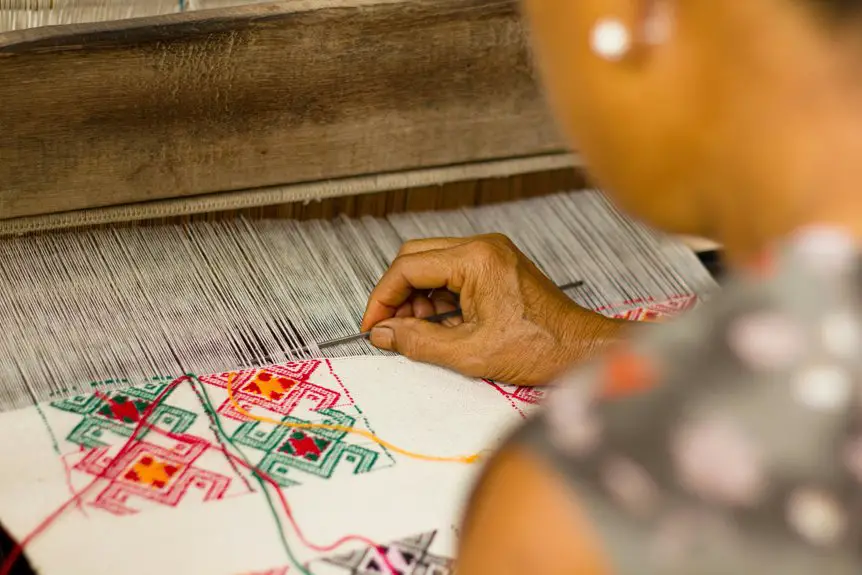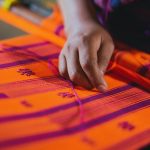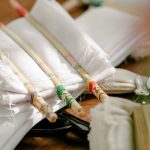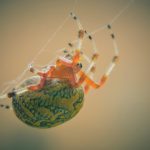You can elevate your textile art with advanced Shibori techniques like Arashi, which wraps fabric around a pole for dynamic diagonal patterns, and Kumo, creating spider web-like designs through tight bindings. Experiment with Itajime’s precise shaped resists or Nui’s stitched textures to add depth. Layer colors carefully using natural dyes and try metallic paints or discharge methods for striking effects. Combining these approaches releases vibrant three-dimensional textures and works on unconventional fabrics, opening fresh creative possibilities. Exploring further reveals even more intricate methods and materials.
Table of Contents
Key Takeaways
- Combine multiple resist techniques like Arashi and Nui Shibori for intricate texture and layered patterns in textiles.
- Layer dyes with partial drying between applications to achieve crisp, vibrant multi-colored Shibori designs.
- Use advanced folding, clamping, and stitching methods to create complex geometric and spontaneous motifs.
- Incorporate metallic paints or discharge methods to add reflective highlights and selective color removal effects.
- Experiment with fabric types and dye absorption properties to enhance color depth and pattern clarity.
Exploring Arashi Shibori: The Storm Technique
When you plunge into Arashi Shibori, also known as the Storm Technique, you’ll discover a method that wraps fabric around a pole before binding and compressing it to create striking diagonal patterns.
You start by tightly wrapping your fabric around a cylindrical object, like a PVC pipe. Then, you bind the fabric firmly with thread or string, securing it in place.
Next, you scrunch and compress the wrapped fabric, which causes the dye to resist certain areas, revealing beautiful storm-like streaks once dyed. The diagonal lines are a result of the fabric’s folds and compression around the pole.
This technique demands precision and patience, but the results are dynamic and unique. You’ll find Arashi Shibori perfect for adding movement and energy to your textile art.
Kumo Shibori: Mastering Spider Web Patterns
Although Kumo Shibori might seem intricate at first, you’ll quickly grasp how to create its distinctive spider web patterns by carefully binding sections of fabric with thread.
The key lies in evenly pinching small areas and wrapping them tightly to resist dye penetration, forming radial lines.
Master Kumo Shibori by evenly pinching and tightly wrapping fabric to create striking radial patterns.
To master this technique, focus on:
- Selecting lightweight cotton or silk for crisp patterns
- Pinching fabric into small bundles, about 1-2 inches wide
- Wrapping each bundle with fine thread, tightening consistently
- Applying dye evenly, allowing it to seep into unbound areas
Itajime Shibori: Precision With Shape-Resist Dyeing
A hallmark of Itajime Shibori lies in its use of shaped resist blocks to create crisp, geometric patterns on fabric.
You fold your cloth, sandwich it between two carved wooden or acrylic blocks, then bind them tightly. This prevents dye from reaching the covered areas, leaving sharp, symmetrical designs when you unfold the fabric.
The shape and size of your blocks directly influence the final pattern, so experiment with triangles, squares, or even custom shapes to achieve unique effects. You’ll want to press the blocks firmly to guarantee clean lines.
This technique offers more control compared to freeform shibori methods, perfect for creating repeatable, structured motifs.
Mastering Itajime Shibori expands your dyeing repertoire, letting you combine precision with creativity in your textile art.
Nui Shibori: Stitching for Intricate Texture
While Itajime Shibori relies on rigid shapes and pressure to create patterns, Nui Shibori brings a more tactile, hands-on approach through stitching. You sew precise running stitches into your fabric, then pull the threads tight to gather and resist dye in intricate ways.
This technique lets you control texture and pattern with subtlety and detail that other Shibori methods can’t match. As you explore Nui Shibori, focus on:
- Varying stitch length for different gathering effects
- Tightening stitches evenly to shape the fabric’s surface
- Choosing strong threads that withstand dye immersion
- Experimenting with curved or linear stitch paths for unique designs
Advanced Folding and Clamping Methods
When you master folding and clamping in Shibori, you reveal patterns that combine geometry with spontaneity. Folding fabric precisely creates symmetry, while clamps add contrast by resisting dye in unique ways. Experiment with various fold methods and clamp types to discover new effects.
| Fold Type | Clamp Style | Resulting Pattern |
|---|---|---|
| Accordion Fold | Wooden Block | Crisp, parallel lines |
| Triangle Fold | Metal Clamp | Sharp, angular motifs |
| Spiral Fold | Clothespin Clamp | Circular, dynamic shapes |
| Fan Fold | Shell Clamp | Radiating, organic forms |
Use this table as your guide, but don’t hesitate to combine techniques for truly personalized Shibori designs.
Combining Shibori With Digital Printing
Mastering advanced folding and clamping methods opens new possibilities for your Shibori patterns, but combining these traditional techniques with digital printing can take your designs even further.
Digital printing lets you add intricate details and vibrant colors that Shibori alone can’t achieve. You can print over your dyed fabric or print first and then apply Shibori for unique textures. This fusion expands your creative toolkit and allows precise control over your artwork.
Consider these tips when combining Shibori with digital printing:
- Choose fabrics that hold dye and print well, like silk or cotton.
- Test print colors on Shibori-dyed fabric to confirm vibrancy.
- Align your digital patterns with your folding and clamping designs.
- Use digital printing to add fine details that complement Shibori’s organic shapes.
Experimenting With Multi-Layered Dyeing
You’ll want to layer your colors carefully to make each shade stand out without muddying the design.
Timing and drying between dye applications play an essential role in achieving crisp results.
Combining different resist techniques can add depth and complexity to your multi-layered patterns.
Layering Colors Effectively
Layering colors in shibori opens up a world of depth and complexity that single-dye techniques can’t achieve. When you layer dyes, each color interacts uniquely with the fabric and previous layers, creating rich, unexpected results.
To layer colors effectively, consider these key points:
- Start with lighter shades first, then gradually add darker tones to avoid muddiness.
- Allow partial drying between dye applications to control blending and prevent colors from bleeding too much.
- Use resist techniques like folding or binding to protect certain areas, ensuring color distinction.
- Test combinations on scrap fabric to predict how colors will merge and adjust your approach accordingly.
Timing and Drying Tips
Although timing can feel tricky at first, controlling drying stages is essential when experimenting with multi-layered dyeing.
You’ll want to let each dye layer dry just enough to prevent unwanted bleeding but not so long that it becomes rigid or hard to manipulate. Ideally, aim for a damp but tacky surface before applying the next color. This balance helps colors blend subtly without muddying.
Keep an eye on humidity and temperature in your workspace since they affect drying speed. Using a fan or natural airflow can speed things up, but avoid direct heat, which may cause uneven drying.
Combining Resist Techniques
When you combine different resist techniques, you release a whole new level of complexity and texture in your Shibori designs.
Layering methods like folding, binding, stitching, and clamping lets you experiment with multi-layered dyeing, producing intricate patterns that a single technique can’t achieve. As you work, consider how each resist impacts dye penetration and how overlapping shapes interact visually.
Try these approaches to enhance your pieces:
- Apply initial folds, then stitch patterns for fine detail.
- Use clamps over tied sections to create bold contrasts.
- Layer multiple dye baths, drying between steps.
- Mix tight bindings with loose folds to vary texture.
Using Natural Dyes in Complex Shibori Designs
How do natural dyes enhance the complexity of your Shibori designs? They bring depth and organic variation that synthetic dyes often lack.
When you use natural dyes like indigo, madder, or walnut, each piece gains unique tonal shifts and subtle irregularities, enriching your patterns. These dyes interact differently with various fabrics and resist techniques, allowing you to explore layered colors and textures.
You’ll notice how folding and binding influence dye absorption, creating intricate gradients and contrasts. Plus, natural dyes respond beautifully to multiple dye baths, so you can build complexity by overdyeing.
Incorporating Metallic and Discharge Techniques
While natural dyes bring organic depth to your Shibori pieces, incorporating metallic and discharge techniques adds striking contrast and texture that can transform your designs.
You can experiment with metallic paints or foils to highlight folds and creases, giving your fabric a luminous, reflective quality. Discharge methods let you remove color selectively, revealing the fabric’s original shade or base color beneath intricate patterns.
To get started:
- Apply metallic leaf or paint to raised areas for shimmering highlights
- Use discharge paste on dark-dyed fabric to create crisp, light motifs
- Combine both techniques to enhance dimensionality and visual interest
- Test on small fabric samples to perfect timing and intensity
These methods open new creative pathways, adding complexity and brilliance to your Shibori work.
Creating Three-Dimensional Effects With Shibori
Adding metallic and discharge techniques can enhance your Shibori pieces, but to truly make your fabric stand out, you’ll want to explore creating three-dimensional effects.
Start by experimenting with stitching and gathering methods like Nui Shibori, which lets you control fabric tension to sculpt raised patterns. You can also try Arashi Shibori, wrapping fabric around a pole before binding tightly to produce dynamic, dimensional textures.
Don’t hesitate to combine pleating with binding to create sculptural folds that catch light differently. Using thicker fabrics or layering can amplify the 3D look, giving your work tangible depth.
Shibori on Unconventional Fabrics and Surfaces
You can push Shibori beyond traditional fabrics by experimenting with leather, which offers a unique texture and dye absorption.
Trying Shibori on metal surfaces also opens up creative possibilities with stunning visual effects.
Let’s explore how these unconventional materials respond to Shibori techniques and what to expect.
Dyeing on Leather
Leather offers a unique challenge and opportunity when applying Shibori dyeing techniques. Unlike fabric, leather’s dense texture absorbs dye differently, requiring careful preparation and handling. You’ll want to test dyes on a small scrap first to guarantee proper absorption without damaging the material.
Follow these tips for effective Shibori on leather:
- Choose water-based dyes or leather-specific pigments to avoid stiffness.
- Moisten leather slightly before dyeing to help the dye penetrate evenly.
- Use gentle folding and binding techniques to prevent cracking.
- Allow the leather to dry slowly in a flat position to maintain shape.
With patience and care, you can create stunning, textured patterns that bring new life to your leather pieces using Shibori methods.
Shibori With Metal
Though Shibori traditionally involves fabric, experimenting with metal surfaces opens exciting possibilities for texture and pattern. You can use techniques like binding, folding, or stitching on thin metal sheets to create unique impressions. Applying patinas or heat-reactive dyes enhances the Shibori effect, producing striking contrasts. Keep in mind metal requires different handling—wear gloves and use appropriate tools. This approach pushes Shibori beyond textiles, blending craft with metalwork.
| Technique | Metal Type | Effect Achieved |
|---|---|---|
| Binding | Copper | Raised patterns |
| Folding | Aluminum | Crisp, geometric lines |
| Stitching | Stainless Steel | Textured, intricate |
Try combining these methods to discover new aesthetic dimensions in your Shibori practice.
Frequently Asked Questions
What Basic Materials Are Needed to Start Shibori Dyeing at Home?
You’ll want some trusty fabric friends like cotton, natural dyes, rubber bands, and wooden blocks for your colorful adventures. Don’t forget gloves, a bucket, and salt to help the magic stick—your creative journey awaits!
How Do You Properly Care for and Wash Finished Shibori Textiles?
You should hand wash your shibori textiles gently in cold water with mild detergent. Avoid wringing or twisting, and air dry them flat away from direct sunlight to preserve colors and fabric integrity.
Can Shibori Techniques Be Adapted for Use With Synthetic Dyes?
You can definitely adapt shibori techniques for synthetic dyes. Just make sure you choose the right dye type for your fabric, follow the dye manufacturer’s instructions, and experiment to achieve the vibrant, precise patterns you want.
What Safety Precautions Should Be Taken When Handling Dye Chemicals?
You’d think handling dye chemicals requires superhero-level caution—and you’d be right! Always wear gloves, work in a well-ventilated area, avoid skin contact, and keep chemicals away from kids and pets to stay safe and stain-free.
Are There Traditional Cultural Meanings Behind Specific Shibori Patterns?
Yes, many shibori patterns hold traditional cultural meanings. You’ll find some symbols represent nature, seasons, or protection. Understanding these meanings can deepen your appreciation and add personal significance to your textile creations.
- What Is a Simple Stain in Microbiology? - July 14, 2025
- How to Create Patterns With the Batik Dyeing Technique - July 14, 2025
- What Is the Low-Dye Technique in Podiatry? - July 14, 2025







